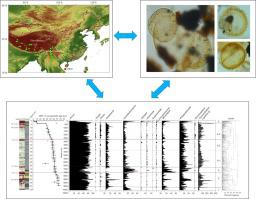当前位置:
X-MOL 学术
›
J. Asian Earth Sci.
›
论文详情
Our official English website, www.x-mol.net, welcomes your feedback! (Note: you will need to create a separate account there.)
Pollen record in the northwestern continental shelf of the South China Sea in the past 82 ka: paleoenvironmental changes in the last glacial period
Journal of Asian Earth Sciences ( IF 3 ) Pub Date : 2020-09-01 , DOI: 10.1016/j.jseaes.2020.104457 Shaohua Yu , Zhuo Zheng , Jan Harff , Fang Chen , Xia Jing , Yang Zhou , Hongjun Chen , Bloom Karolina , Borówka Ryszard
Journal of Asian Earth Sciences ( IF 3 ) Pub Date : 2020-09-01 , DOI: 10.1016/j.jseaes.2020.104457 Shaohua Yu , Zhuo Zheng , Jan Harff , Fang Chen , Xia Jing , Yang Zhou , Hongjun Chen , Bloom Karolina , Borówka Ryszard

|
Abstract The northwestern continental shelf of the South China Sea (SCS) is in a geographic location that was sensitive to the global paleoenvironmental change during the last glacial period. Here we present a high resolution palynological record of Core ZBW (100.65 m in length) from the continental shelf of the SCS in the past 82 ka. In contrast to results for the northern SCS, the core’s pollen assemblage was dominated by arboreal trees between MIS5a and MIS1, even during the glacial period. Pollen provenance analyses indicated it was mainly from the drainage basin of the Red River, the Yungui Plateau and Tibetan Plateau. Between 66 and 64 ka, the contribution of Pinus fell while that of Cyclobalanopsis and trilete spores increased, indicating a drier and cooler climate. Conversely, during MIS3, the contributions of Pinus and lowland trees were high, indicating a warm and wet climate. The sedimentary environment in core ZBW alternated between coastal marine and river alluvial or shore facies. A sedimentary hiatus between 42 and 13 ka coincided with a significant fall in sea levels. Seismic data indicate that the Hainan paleo-river Delta (HPRD) process occurred at the core site between 65 and 56 ka, with extremely high rates of sediment deposition. Pollen data indicate the HPRD process was coincided with a transition period from cooler and drier climate to warmer and wetter climate, and lower sea levels to higher sea levels.
中文翻译:

近82 ka南海西北大陆架花粉记录:末次冰期古环境变化
摘要 南海西北大陆架(SCS)处于末次冰期全球古环境变化敏感的地理位置。在这里,我们展示了过去 82 ka 中南海大陆架核心 ZBW(长 100.65 m)的高分辨率孢粉学记录。与南海北部的结果相反,核心的花粉组合在 MIS5a 和 MIS1 之间以乔木树为主,即使在冰川时期也是如此。花粉种源分析表明,主要来自红河流域、云贵高原和青藏高原。66~64 ka,松树的贡献率下降,而圆兰和三叶孢子的贡献率上升,表明气候干燥凉爽。相反,在 MIS3 期间,松和低地树木的贡献高,表明气候温暖湿润。ZBW 核心沉积环境在沿海海相和河流冲积相或海岸相之间交替。42 到 13 ka 之间的沉积中断与海平面的显着下降同时发生。地震资料表明,海南古河三角洲(HPRD)过程发生在65-56ka的核心位置,沉积物沉积速率极高。花粉数据表明,HPRD 过程恰逢从凉爽干燥气候向温暖湿润气候、从低海平面到高海平面的过渡时期。42 到 13 ka 之间的沉积中断与海平面的显着下降同时发生。地震资料表明,海南古河三角洲(HPRD)过程发生在65-56ka的核心位置,沉积物沉积速率极高。花粉数据表明,HPRD 过程恰逢从凉爽干燥的气候向温暖湿润的气候、从低海平面到高海平面的过渡时期。42 到 13 ka 之间的沉积中断与海平面的显着下降同时发生。地震资料表明,海南古河三角洲(HPRD)过程发生在65-56ka的核心位置,沉积物沉积速率极高。花粉数据表明,HPRD 过程恰逢从凉爽干燥气候向温暖湿润气候、从低海平面到高海平面的过渡时期。
更新日期:2020-09-01
中文翻译:

近82 ka南海西北大陆架花粉记录:末次冰期古环境变化
摘要 南海西北大陆架(SCS)处于末次冰期全球古环境变化敏感的地理位置。在这里,我们展示了过去 82 ka 中南海大陆架核心 ZBW(长 100.65 m)的高分辨率孢粉学记录。与南海北部的结果相反,核心的花粉组合在 MIS5a 和 MIS1 之间以乔木树为主,即使在冰川时期也是如此。花粉种源分析表明,主要来自红河流域、云贵高原和青藏高原。66~64 ka,松树的贡献率下降,而圆兰和三叶孢子的贡献率上升,表明气候干燥凉爽。相反,在 MIS3 期间,松和低地树木的贡献高,表明气候温暖湿润。ZBW 核心沉积环境在沿海海相和河流冲积相或海岸相之间交替。42 到 13 ka 之间的沉积中断与海平面的显着下降同时发生。地震资料表明,海南古河三角洲(HPRD)过程发生在65-56ka的核心位置,沉积物沉积速率极高。花粉数据表明,HPRD 过程恰逢从凉爽干燥气候向温暖湿润气候、从低海平面到高海平面的过渡时期。42 到 13 ka 之间的沉积中断与海平面的显着下降同时发生。地震资料表明,海南古河三角洲(HPRD)过程发生在65-56ka的核心位置,沉积物沉积速率极高。花粉数据表明,HPRD 过程恰逢从凉爽干燥的气候向温暖湿润的气候、从低海平面到高海平面的过渡时期。42 到 13 ka 之间的沉积中断与海平面的显着下降同时发生。地震资料表明,海南古河三角洲(HPRD)过程发生在65-56ka的核心位置,沉积物沉积速率极高。花粉数据表明,HPRD 过程恰逢从凉爽干燥气候向温暖湿润气候、从低海平面到高海平面的过渡时期。



























 京公网安备 11010802027423号
京公网安备 11010802027423号